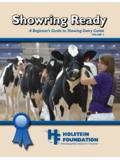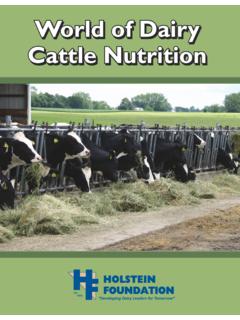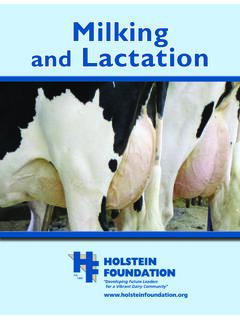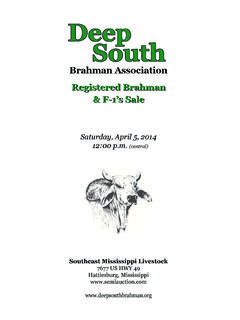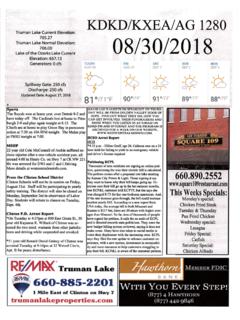Transcription of Working With Dairy Cattle - Holstein Foundation
1 Working with Dairy Cattle Working with Dairy Cattle '' is designed for youth interested in developing a Dairy Objectives of Cattle project. It was created to help young people build skills in selecting, Working with raising, and managing a Dairy heifer from a calf to a milking cow. Dairy Cattle Your heifer project will provide you with an For more information contact: opportunity to raise Dairy calves and learn more Holstein Foundation about various management procedures. This PO Box 816. handbook is not a complete directory of everything Brattleboro, VT 05302-0816. you will need to know to raise a calf. Instead, it is Telephone: 800-952-5200. a guide which provides hints that will help make your experience of raising a calf both educational Information and editorial guidance and successful. The information provided has been provided by: collected from a variety of sources such as state Kelli Dunklee extension bulletins, University publications and 4-H.
2 Ed Peck handbooks. Dr. Katherine M. Swift Lindsey Worden Becoming involved with Cattle will give you the chance to raise and care for Dairy animals, from calves to cows. A. project such as this can help you .. TABLE. TABLE OF. OF CONTENTS. CONTENTS develop basic techniques in feeding and caring for an animal;. learn the principles of good record keeping;. Objectives of Working with Dairy 2 develop basic marketing principles;. gain experience in buying, developing and showing Selecting Your 3 an animal;. Feeding Your 6 learn how to present an animal and yourself before the public;. Housing for Your 8 develop good, personal character;. gain leadership experience. Health and Management of Your 9. Preparing Your Cattle for Show or 12 Local breed clubs, 4-H clubs and FFA chapters may offer additional aid and instruction to help you get involved in Selecting a Service Sire for Your 14 the Dairy industry.
3 Two approaches that have been used are: Preparing for 15. 1. THE BIG-BROTHER APPROACH - You may be assigned Milking 16 to an individual adult who is knowledgeable about Dairy Cattle . The adult will assist and advise you in selecting a Feeding the Lactating 18 calf, feeding the heifer, breeding her, preparing for a show Treatment During the Dry 19 and any other management decisions you need to make. Identification Record 20 2. THE PROJECT LEADER and ASSISTANT - Two or more adult leaders will work as a unit to help the group of youth Managment 21. interested in Dairy with the management decisions outlined Breeding and Calving 22 above. The leaders either volunteer or are appointed. Summary of Producing 23. Dairy Cow Unified 24. Breed 25. 2. Selecting Your Heifer As you begin your project, you must decide whether you want a replacement project or a breeding project. A replacement heifer will be sold just prior to calving.
4 You will make arrangements for selling the animal at that time. A breeding project includes calves that are kept and raised beyond calving. You will need to learn more about milking procedures and develop other skills necessary for managing lactating animals. When beginning your search for a project animal, you should consider getting assistance or advice from an experienced breeder. This may be a knowledgeable neighbor or even a family member such as a Herd dispersals are different from breed sales as parent or sibling. the animals are from one particular herd when the Dairy is no longer continuing operation. Dispersals Whomever you choose should help you decide include both the top and bottom of the herd and, what selection information is important. What are as with any sale, need to be considered on an your goals for this project? Most people want to individual animal basis.
5 Have a show winner. However, to be profitable and stay in the herd, your heifer will have to be a good The environmental conditions in which a calf is producer with functional type when she is a mature born and its ancestors are kept play a large role in cow. Make certain that the selected animal fits your each animal's performance. Therefore, you must overall goals for this project. consider management of the herd you purchase from. You want to begin your project by investing with your goals clearly in mind, you may begin in a superior animal. searching for your project animal. Neighboring breeders or your own family are often a good When looking for a calf, you likely will use pedigree place to begin the process. They may be willing to information to make wise purchases. Pedigrees sell you a high-quality calf at a reasonable price. provide performance and genetic facts needed by Buying from someone you know also provides the potential buyers.
6 Advantage of knowing the environment where the calf was born and where the dam is producing. A pedigree is simply a record of an animal's ancestry. It provides genetic and performance Local breed sales and herd dispersals are other information on the individual and its ancestors. Sire options for purchasing your animal. Breed sales and dam information can help predict how well a tend to emphasize animals of higher genetic merit heifer will milk and classify as a mature cow. You and ancestor performance. For this reason, animals should look for the pedigree information that will in breed sales tend to sell for a higher premium. tell you how close that animal might come toward Higher price, however, does not guarantee a meeting your specific goals. superior animal. 3. To effectively analyze a pedigree, you should be familiar with the information provided on it. The Holstein Foundation workbook, Pedigree Questions and Answers, covers this topic in more detail.
7 Some information provided on pedigrees includes: 1. PTPI (Pedigree Total Performance Index). estimates the ability of the young animal to transmit a combination of production and type traits. 2. The P level indicates the young animal's percentile ranking based on PTPI and compares registered animals of the same sex born in the same year. 3. PTAs (Predicted Transmitting Abilities). express the level of genetic superiority that an animal is expected to transmit to its offspring for a given production or type trait. These values are used to rank animals based on their genetic merit. 4. TPI (Total Performance Index) and CTPI (Cow TPI) combines PTA protein, PTA fat, PTA type and Udder Composite index to rank animals on their ability to transmit a balance of these four A calf sired by an outstanding, young, unproven sire traits. also could be selected for your project, providing the 5.
8 The Udder Composite index (UDC) combines sire meets your individual pedigree requirements. linear type trait information on seven udder His dam should have a high genetic merit for milk, traits into a single number value. fat and protein and have an acceptable classification score. The young bull's sire should be among the When reviewing a calf's pedigree, consider the breed's top bulls based on his PTAs for both type following: and production. a. The dam should have above average PTAs for milk, fat and protein production. The cow You may choose to study the records of maternal should be functionally sound for type. Evaluate sisters and the maternal granddam to further her classification for final score and udder and evaluate the pedigree. However, primary emphasis be certain that her hind legs and feet are free of should be given to the sire, dam and maternal serious defects.
9 Grandsire. b. The sire should be high-ranking for PTAs of the The following checklist describes some pedigree production traits as well as for overall type. He information that you may find helpful in your also should improve one or more functional type selection. Generally, you will want the heifer's sire traits. Functional type traits include the udder and dam to be above average for these genetic traits and rear legs and feet. measures. c. The maternal grandsire also may be evaluated for genetic merit when performance information What is the heifer's PTPI? on the dam in not available. (For example: if What is her P level? the dam is a two-year-old with no completed What are the sire's PTAs for all production traits? production records or no PTA information.) What is the sire's PTA for type? What is the sire's TPI? What is the dam's CTPI? What is the dam's PTA for protein, fat, milk and type?
10 What are the dam's milk production records? What is the dam's final classification score? When is the animal born? 4. Even though we recommend that these Udder development is difficult to predict; however, performance guidelines be met, common sense and teat placement can be emphasized in young good judgement should be used when selecting heifers. Future teat size also can be determined your project heifer. Careful consideration also should fairly accurately. Udder shape and strength of be given to the physical appearance of the animal attachments in a heifer are difficult to determine, itself. except occasionally when the udder has begun to develop. For young animals, major emphasis should be placed on functional type traits that will determine whether If you select your heifer by combining pedigree the calf will develop into a productive cow. A heifer promise and physical appearance, you will have that has good feet and legs and shows outstanding a better chance of developing a top animal.
